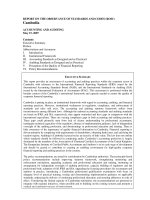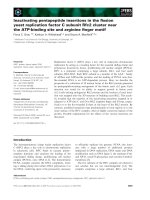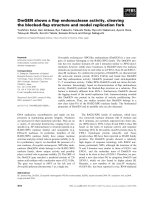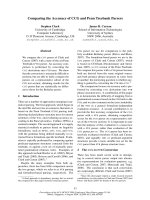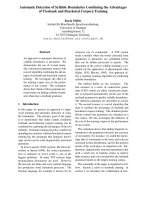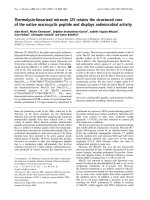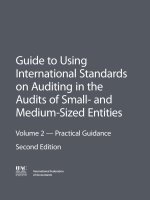The cyclooxygenases NV Chandrasekharan and Daniel L Simmons doc
Bạn đang xem bản rút gọn của tài liệu. Xem và tải ngay bản đầy đủ của tài liệu tại đây (188.11 KB, 7 trang )
Genome Biology 2004, 5:241
comment
reviews
reports deposited research
interactions
information
refereed research
Protein family review
The cyclooxygenases
NV Chandrasekharan and Daniel L Simmons
Address: Department of Chemistry and Biochemistry, Brigham Young University, Provo, UT 84602, USA.
Correspondence: NV Chandrasekharan. E-mail:
Summary
Cyclooxygenases (COXs) catalyze the rate-limiting step in the production of prostaglandins,
bioactive compounds involved in processes such as fever and sensitivity to pain, and are the
target of aspirin-like drugs. COX genes have been cloned from coral, tunicates and vertebrates,
and in all the phyla where they are found, there are two genes encoding two COX isoenzymes; it
is unclear whether these genes arose from an early single duplication event or from multiple
independent duplications in evolution. The intron-exon arrangement of COX genes is completely
conserved in vertebrates and mostly conserved in all species. Exon boundaries largely define the
four functional domains of the encoded protein: the amino-terminal hydrophobic signal peptide,
the dimerization domain, the membrane-binding domain, and the catalytic domain. The catalytic
domain of each enzyme contains distinct peroxidase and cyclooxygenase active sites; COXs are
classified as members of the myeloperoxidase family. All COXs are homodimers and monotopic
membrane proteins (inserted into only one leaflet of the membrane), and they appear to be
targeted to the lumenal membrane of the endoplasmic reticulum, where they are N-glycosylated.
In mammals, the two COX genes encode a constitutive isoenzyme (COX-1) and an inducible
isoenzyme (COX-2); both are of significant pharmacological importance.
Published: 27 August 2004
Genome Biology 2004, 5:241
The electronic version of this article is the complete one and can be
found online at />© 2004 BioMed Central Ltd
Gene organization and evolutionary history
Cyclooxygenases (COXs), also known as prostaglandin H
synthases or prostaglandin endoperoxide synthases (E.C.
1.14.99.1), are fatty-acid oxygenases of the myeloperoxidase
superfamily that are most closely related to the pathogen-
inducible oxidases and linoleate diol synthases of plants
and fungi [1]. The purification of COX-1 (then called simply
COX) from sheep [2] and bovine [3] seminal vesicles in
1976 led to the cloning of the COX-1 gene in 1988 [4-6]. For
many years, it was thought that the constitutively active
COX-1 protein was the only cyclooxygenase in eukaryotic
cells, but in 1991 a second, inducible enzyme was identified
through studies of cell division; this second enzyme is now
called COX-2 [7,8]. The structure of the human COX-1 and
COX-2 genes are shown in Figure 1a, and the properties of
COX-1 and COX-2 and the genes encoding them are com-
pared in Table 1.
All vertebrates investigated, including cartilaginous fishes,
bony fishes, birds, and mammals, have two COX genes: one
encoding the constitutive COX-1 and another the inducible
COX-2. COX-1 and COX-2 share approximately 60-65%
amino-acid identity with each other; COX-1 orthologs
(without the signal peptide) share approximately 70-95%
amino-acid identity across vertebrate species and COX-2
orthologs share 70-90%. Additionally, coral (of the phylum
Cnidaria) and sea squirt (ascidian) each have two COX
genes, which may have arisen from gene-duplication events
independent from those that produced vertebrate COX-1
and COX-2 [9]. It is clear that the vertebrate, coral and
ascidian COX genes all descend from a common ancestor.
Intron-exon junctions are highly conserved in all species,
with a few notable exceptions: the vertebrate COX-1 genes
contain an extra intron (intron 1), and the ascidian and coral
genes have extra introns or lack some exons in the regions
that encode exons 6, 7 or 11 in vertebrate COX-1 [9]. The
exon structures of COX genes largely reflect the domains
encoded by the proteins (Figure 1b). The structure of human
cyclooxygenase genes and their expression and regulation
have been reviewed elsewhere [10].
COX genes have not been found in insects, unicellular organ-
isms, or plants, although prostaglandins, their products, have
been found in some of these organisms [11]. Recently, an
enzyme that catalyzes the synthesis of prostaglandin E
2
from
arachidonic acid (the substrate of COXs) was cloned from the
protozoan Entamoeba histolytica. This enzyme shows no
241.2 Genome Biology 2004, Volume 5, Issue 9, Article 241 Chandrasekharan and Simmons />Genome Biology 2004, 5:241
Figure 1
Primary structures of COX genes and COX proteins. (a) Schematic representation of human COX-1 and COX-2 genes and the mRNAs they encode
(shown as white bars below the genes). Black boxes in the genes and white boxes in the mRNAs denote exons; numbers above each gene are exon
numbers while numbers within the white boxes indicate the size of each exon in nucleotides; single lines in the genes indicate introns and untranslated
regions of first and last exons (the latter being shown as gray boxes in the mRNAs). Adapted from [10]. (b) Schematic representation of human COX
proteins (all known vertebrate proteins have the same general arrangement). Numbers denote amino-acid residues; the exons encoding each domain are
shown on bars below the proteins; important residues are indicated as shown in the key (and with letters in the single-letter amino-acid code, with a
subscript number indicating the residue number). Sp, signal peptide; Dm, dimerization domain; EG; epidermal growth factor domain; Mb, membrane-
binding domain; Cat, catalytic domain.
H
3
N
+
COO
−
H
3
N
+
COO
−
Sp
Dm/EG
DmMb Cat
N
396
H
193
Q
189
H
374
S
516
N
53
N
130
V
509
N
580
5′
3′
5′
3′
135 87 117 141 144 182 84 247
12 3 45 6 7 8 9 10
123456789 10
11
287 148 353
117 144 144 182 84 247 287 148 407134 52
1-2 3 4 5-11
1 2 3 4-10
Exons
Exons
Glycosylation site
Residue involved in
heme coordination
Serine acetylated
by aspirin
735
~2000
7
Gene
Gene
mRNA
mRNA
Human COX-1
Human COX-1
Human COX-2
Human COX-2
N
409
H
206
Q
202
H
387
Y
384
Y
371
S
529
N
143
N
67
1
24
69
116
596
599
31
140
Sp
Dm/EG DmMb Cat
1
56
104
599
604
18
128
(a)
(b)
Tyrosine at
active site
Valine in COX-2
active site
clear structural similarity to COXs, suggesting that alternative
evolutionary paths to prostaglandin synthesis have evolved in
some organisms [12].
Characteristic structural features
COXs are all close to 600 amino acids in size and have a
similar primary structure [13,14] (Figure 1b). The crystal
structure of sheep COX-1 (minus the post-translationally
cleaved signal peptide), was obtained in 1994 [15]; human
and mouse COXs have since been crystallized and show strik-
ingly similar features [16,17]. After the signal peptide, the
amino terminus of the protein contains a single epidermal
growth factor (EGF) module with conserved disulfide bonds
that functions as a dimerization domain. This is followed by a
series of four amphipathic helices that anchors the protein to
one leaflet of the membrane. This ‘monotopic’ type of inser-
tion into a membrane has been found only in this enzyme and
a few other proteins such as squalene cyclase and S-mandelate
dehydrogenase [18,19]. The remainder of the protein consists
of the catalytic domain, which has two distinct cyclooxy-
genase and peroxidase active sites.
COXs are highly conserved, and few significant differences are
seen in the dimerization, membrane-binding and catalytic
domains between COXs from different species. The amino-
terminal hydrophobic signal peptides differ significantly in
length between species. In the case of two splice variants of
canine COX-1, the signal peptide has been found not to be
cleaved from the enzyme when expressed in insect cells [20].
The catalytic domain contains conserved alpha-helical struc-
tures and a heme-binding motif shared with other peroxi-
dases [15]. COXs are glycosylated on asparagine in all
organisms. One N-glycosylation site (Asn143, using the
numbering of human COX-1) is absolutely conserved, and
other sites are shifted only slightly in different homologs.
For example, Asn410 in sheep COX-1 (orthologous to
comment
reviews
reports deposited research
interactions
information
refereed research
Genome Biology 2004, Volume 5, Issue 9, Article 241 Chandrasekharan and Simmons 241.3
Genome Biology 2004, 5:241
Table 1
Properties of human COX-1 and COX-2 and the genes encoding them
Property COX-1 COX-2
Chromosomal location of gene 9q32-q33.3 1q25.2-25.3
Copy number of gene Single Single
Gene size About 22 kb About 8 kb
Number of exons 11 10
Number of introns 10 9
Length of primary mRNA 2.8 kb 4.5 kb
Length of differentially polyadenylated variants 4.5 kb, 5.2 kb 4.0 kb, 2.8 kb
Lengths of splice variants See [13,34] See [13,34]
Length of coding region 1,797 nucleotides 1,812 nucleotides
Putative transcription regulatory elements found in:
promoter TATA-less TATA box
5Ј upstream region* AP-2, GATA-1, NF-IL6, NFκB, PEA-3, AP-2, C/EBP, CRE, GATA-1, GRE, NF-IL6, NFκB,
SP-1, SSRE PEA-3, SP-1
3Ј untranslated region AUUUA repeats
Expression Constitutive Inducible (by cytokines, growth factors and so on [10,35])
Length of protein (with signal peptide) 599 amino acids 604 amino acids
Length of mature protein (without signal peptide) 576 amino acids 581 amino acids
Number of glycosylation sites 3 3-4 (variable)
Cofactors Heme Heme
Substrates Arachidonic acid Arachidonic acid and others
Quaternary structure Homodimer Homodimer
Subcellular location Endoplasmic reticulum Endoplasmic reticulum and nuclear envelope
Information from [10,13,35]. *Abbreviations: CRE, cyclic AMP response element; GATA-1, binding site containing GATA sequence bound by the
GATA 1 transcription factor; GRE, glucocorticoid-response element; SSRE, shear-stress response element; other abbreviations denote the transcription
factors bound by the regulatory elements shown: AP-2, activator protein 2; C/EBP, CCAAT/enhancer-binding protein; NF-IL6, nuclear factor for
interleukin 6; NFκB, nuclear factor κB; PEA-3, polyoma enhancer activator; SP-1, transcription factor SP-1.
Asn409 in human COX-1), found to be essential for folding
[21], is shifted to Asn394 in coral COXs. The cyclooxygenase
active site is a narrow tunnel, approximately 8 Å wide and
25 Å long, that opens in the membrane-binding domain
(Figure 2). This site accepts the arachidonic acid that is lib-
erated from the membrane by cellular phospholipases.
Amino acids lining this site are largely hydrophobic and
serve to ‘solvate’ the hydrophobic substrate into the site [22].
Exceptions to this hydrophobicity are Arg119, Tyr384 and
Ser529 (numbered according to the human COX-1 enzyme
sequence). Arg119 coordinates the carboxyl group of arachi-
donic acid by a salt bridge or hydrogen bond; Ser529
coordinates the geometry of attack in the complex bis-dioxy-
genation reaction performed; and Tyr384 forms a critical
tyrosyl radical that initiates the cyclooxygenase reaction by
abstraction of hydrogen from arachidonic acid (see Mecha-
nism section). Non-steroidal anti-inflammatory drugs
(NSAIDs) competitively inhibit the cyclooxygenase active
site; an exception is the NSAID aspirin, which covalently
modifies the enzyme by acetylating Ser529. In contrast to the
cyclooxygenase active site, the peroxidase site is a solvent
accessible cleft located on the surface of the enzyme furthest
from the membrane (Figure 2).
Localization and function
COX-1 is ubiquitously and constitutively expressed in mam-
malian tissues and cells, whereas COX-2 is highly inducible
and is generally present in mammalian tissues at very low
levels, unless increased by one of many types of stimuli such
as cytokines and growth factors.
Both COXs are largely located on the lumenal side of the
endoplasmic reticulum (ER) membrane and the nuclear
envelope, although they have also been detected in some sit-
uations in lipid bodies, mitochondria, filamentous struc-
tures, vesicles and in the nucleus [23-26]. The lumen of the
ER is important for both the structure and function of COXs:
its oxidative potential allows formation of the disulfide
bonds of the enzymes, and N-linked glycosylation - which
occurs in the ER - appears to be necessary for proper protein
folding [21]. Moreover, the final product of COXs,
prostaglandin H
2
, is sufficiently non-polar to diffuse through
the membrane of the ER to isomerases located on the
cytosolic surface of the ER or in the cytosol (Figures 2, 3).
Lipid bodies may provide a similar environment, but the role
of COXs in the nucleus is unknown.
Both classes of COX are bifunctional enzymes with two dis-
tinct catalytic activities: cyclooxygenase (or bis-dioxygenase)
activity and peroxidase activity (Figure 3a). The primary
products of COXs were first detected in human seminal fluid
by clinicians studying uterine contraction [27]. Thought to be
the product of the prostate gland, these highly potent bioac-
tive compounds were given the name prostaglandins. They
are synthesized in virtually all tissues in vertebrates, however,
and some organisms that lack prostate glands, such as corals,
also synthesize prostaglandins. Thus, in many respects the
term prostaglandin is a misnomer. Initially, the enzyme activ-
ity that synthesized prostaglandins was frequently called
prostaglandin synthetase, but because it does not require ATP
it is now called prostaglandin G/H synthase to fit the nomen-
clature convention. It is more popularly known as cyclooxy-
genase, a name that only partially describes the enzyme since
it refers to only one of its two enzymatic activities.
Prostaglandin isomers - including thromboxane and
prostaglandins D
2
, E
2
, F
2α
, and I
2
(prostacyclin; Figure 3b) -
function in numerous physiological and pathophysiological
processes, such as pyresis (fever), algesia (sensitivity to
pain), inflammation, thrombosis, parturition, mitogenesis,
vasodilation and vasoconstriction, ovulation, and renal func-
tion. Prostaglandin isomers act upon G-protein-coupled
receptors [28], and there are multiple receptors for some
isoforms (such as prostaglandin E
2
). Prostaglandins are
short-lived in vivo (with half-lives of seconds to minutes),
and act in an autocrine or a paracrine rather than an
endocrine fashion. COX-1 was first studied in tissue and cell
homogenates, and in this context was shown by Vane [29] to
be the inhibitory target of NSAIDs.
Mechanism
The cyclooxygenase activity of COXs oxygenates arachidonic
acid to produce prostaglandin G
2
, a cyclopentane hydroperoxy
endoperoxide; the peroxidase activity of COXs then reduces
241.4 Genome Biology 2004, Volume 5, Issue 9, Article 241 Chandrasekharan and Simmons />Genome Biology 2004, 5:241
Figure 2
Cross-section of a cyclooxygenase monomer in the lumen of the
endoplasmic reticulum, showing the two distinct catalytic sites. Cx,
cyclooxygenase catalytic site; Mb, membrane-binding domain; Px,
peroxidase catalytic site.
Px
Cx
Mb
Lumen of
endoplasmic
reticulum
Cytosol
Arachidonic
acid + O
2
Prostaglandin G
2
Prostaglandin H
2
Prostaglandin H
2
this to prostaglandin H
2
(Figure 3a). The two reactions are
functionally interconnected (see below and Figure 3c). A
branch-chain reaction mechanism for COX, indicating that
the two reaction cycles are coupled, was first proposed by Ruf
and colleagues [30]. The mechanism by which arachidonic
acid is converted to prostaglandin H
2
has been the subject of
excellent reviews [31,32]. The newly synthesized COX enzyme
needs to be activated at Tyr384 (in human COX-1; Tyr371 in
human COX-2) to produce a tyrosyl radical; this activation
involves the heme in the peroxidase site (see Figure 3b). The
tyrosyl radical converts arachidonic acid to an arachidonyl
radical, which reacts with two molecules of oxygen to yield
prostaglandin G
2.
This then diffuses to the peroxidase site and
is reduced to prostaglandin H
2
by the peroxidase activity. The
cyclooxygenase activity is dependent on heme oxidation - that
is, on the peroxidase activity - but continuous peroxidase
activity is not necessary for cyclooxygenase activity, as the
tyrosyl radical is regenerated in each catalytic cycle (Figure
3c). Prostaglandin H
2
is the root prostaglandin from which
prostaglandin isomers such as thromboxane and prostacyclin
are made by downstream synthases, via isomerization and
oxidation or reduction reactions (Figure 3b). Cyclooxygenases
have short catalytic life spans (frequently 1-2 minutes at V
max
in vitro) because the enzyme is autoinactivated. The mecha-
nism of autoinactivation is unknown, but reactive tyrosyl radi-
cals may cause internal protein modification.
Frontiers
The exact distinct functions of COX-1 and COX-2 are still
being unraveled [33]. There is increasing evidence for the
involvement of COXs in the development and progression of
cancer, Alzheimer’s disease and other pathophysiological
states. Development of therapeutic and diagnostic tools to
treat these diseases is being actively investigated. Moreover,
variants of cyclooxygenase derived from alternative splicing
comment
reviews
reports deposited research
interactions
information
refereed research
Genome Biology 2004, Volume 5, Issue 9, Article 241 Chandrasekharan and Simmons 241.5
Genome Biology 2004, 5:241
Figure 3
Production of prostaglandins by COXs. (a) The two reactions performed by cyclooxygenases: the conversion of arachidonic acid to prostaglandin G
2
by
the cyclooxygenase activity and the conversion of prostaglandin G
2
to prostaglandin H
2
by the peroxidase activity. (b) The cell-specific synthases that are
involved in the conversion of prostaglandin H
2
to the five principal prostaglandins. (c) The reaction mechanism of COX-1. (1) First, a ferryl-oxo (FeIV)
protoporphyrin radical in the heme in the peroxidase active site is produced when endogenous oxidant(s) oxidizes ferric heme (FeIII) to ferryl-oxo
(FeIV) protoporphyrin radical through a two-electron oxidation. (2) The Tyr384 residue in the cyclooxygenase active site is activated, through a single-
electron reduction reaction with the FeIV protoporphyrin radical, to produce a tyrosyl radical. In the first step of the oxygenation process (3), the
13-pro(S) hydrogen of arachidonic acid in the COX site is abstracted by the tyrosyl radical to produce the arachidonyl radical. (4) This is followed by the
reaction of the arachidonyl radical with two molecules of oxygen, to yield prostaglandin G
2
. (5) Prostaglandin G
2
then diffuses (dotted line) to the
peroxidase active site and is reduced to prostaglandin H
2
by the peroxidase activity (1). AA, arachidonic acid; EnR, an endogenous reductant; Fe
+++
, ferric
heme; Fe=O
++++•
, Ferryl-oxo FeIV porphyrin radical; Tyr-OH, active site tyrosine; Tyr-O
•
, tyrosyl radical.
H
3
COOH COOH COOH
OOH OH
O
O
O
O
Arachidonic acid
Prostaglandin G
2
Prostaglandin H
2
Cyclooxygenase Peroxidase
2O
2
+
Prostaglandin D
synthase
Prostaglandin H
2
Prostaglandin F
2α
Prostaglandin F
synthase
Prostaglandin E
synthase
Thromboxane
synthase
O
O
CH
3
COOH
Cell-specific synthases
Prostaglandin D
2
HO
CH
3
O
COOH
OH
HO
HO
CH
3
COOH
OH
Prostaglandin E
2
CH
3
HO
O
COOH
OH
Prostaglandin I
2
(prostacyclin)
HO
O
C
COOH
OH
Thromboxane A
2
O
CH
3
O
COOH
OH
OH
Prostacyclin
synthase
Peroxidase
active site
Cyclooxygenase
active site
EnR
EnR
AA
AA
•
Tyr-O
•
Tyr-OH
PGG
2
PGG
2
•
2 O
2
PGG
2
PGH
2
Fe
+++
Fe=O
++++
Fe=O
++++•
1
2
3
4
5
(a)
(b) (c)
have been reported (reviewed in [13,34]). Elucidation of the
roles played by these variants could provide greater insight
into the roles of COXs in physiology and disease.
Acknowledgements
This work was supported by National Institute of Health grant AR 46688
and Merck, USA. We wish to thank K.L.T. Roos, D. Melville and
C. Gurney for helping us in numerous ways.
References
1. Daiyasu H, Toh H: Molecular evolution of the myeloperoxi-
dase family. J Mol Evol 2000, 51:433-445.
An evolutionary analysis of the myeloperoxidases.
2. Hemler M, Lands WEM, Smith WL: Purification of the cyclooxy-
genase that forms prostaglandins: demonstration of two
forms of iron in the holoenzyme. J Biol Chem 1976, 251:5575-
5579.
The first isolation and purification of cyclooxygenase from sheep
seminal vesicles.
3. Miyamoto T, Ogino N, Yamamoto S, Hayaishi O: Purification of
prostaglandin endoperoxide synthetase from bovine vesicu-
lar gland microsomes. J Biol Chem 1976, 251:2629-2636.
The first isolation and purification of cyclooxygenase enzyme from
bovine seminal vesicles.
4. Yokoyama C, Tanabe T: Cloning of human gene encoding
prostaglandin endoperoxide synthase and primary structure
of the enzyme. Biochem Biophys Res Commun 1989, 165:888-894.
The cloning of human cyclooxygenase-1 (COX-1).
5. Merlie JP, Fagan D, Mudd J, Needleman P: Isolation and charac-
terization of the complementary DNA for sheep seminal
vesicle prostaglandin endoperoxide synthase (cyclooxy-
genase). J Biol Chem 1988, 263:3550-3553.
The cloning of the first cyclooxygenase gene from sheep.
6. DeWitt DL, Smith WL: Primary structure of prostaglandin
G/H synthase from sheep vesicular gland determined from
the complementary DNA sequence. Proc Natl Acad Sci USA
1988, 85:1412-1416.
The cloning of the first cyclooxygenase gene from sheep.
7. Xie W, Chipman JG, Robertson DL, Erikson RL, Simmons DL:
Expression of a mitogen-responsive gene encoding
prostaglandin synthase is regulated by mRNA splicing. Proc
Natl Acad Sci USA 1991, 88:2692-2696.
The first report on the cloning and characterization of a second
isozyme of cyclooxygenase (COX-2).
8. Kujubu DA, Fletcher BS, Varnum BC, Lim RW, Herschman HR:
TIS10, a phorbol ester tumor promoter-inducible mRNA
from Swiss 3T3 cells, encodes a novel prostaglandin syn-
thase/cyclooxygenase homologue. J Biol Chem 1991, 266:12866-
12872.
Cloning and characterization of a second isozyme of cyclooxygenase
(COX-2).
9. Jarving R, Jarving I, Kurg R, Brash AR and Samel N: On the evolu-
tionary origin of cyclooxygenase (COX) isozymes: charac-
terization of marine invertebrate COX genes points to
independent duplication events in vertebrate and inverte-
brate lineages. J Biol Chem 2004, 279:13624-13633.
An evolutionary analysis of invertebrate cyclooxygenases.
10. Tanabe T, Tohnai N: Cyclooxygenase isozymes and their gene
structures and expression. Prostaglandins Other Lipid Mediat 2002,
68-69:95-114.
A review on the gene structures and expression of COX-1 and COX-2.
11. Bundy GL: Nonmammalian sources of eicosanoids. Adv
Prostaglandin Thromboxane Leukot Res 1985, 14:229-262.
A review on prostaglandins from nonmammalian sources.
12. Dey I, Keller K, Belley A, Chadee K: Identification and charac-
terization of a cyclooxygenase-like enzyme from Entamoeba
histolytica. Proc Natl Acad Sci USA 2003, 100:13561-13566.
The cloning of a prostaglandin-producing enzyme unrelated to the
cyclooxygenases.
13. Simmons DL, Botting RM, Hla T: Cyclooxygenase isozymes: the
biology of prostaglandin synthesis and inhibition. Pharmacol
Rev, in press.
A review on the biology of prostaglandin synthesis and inhibition by
non-steroidal anti-inflammatory drugs (NSAIDs).
14. Garavito RM, Malkowski MG, DeWitt DL: The structures of
prostaglandin endoperoxide H synthases-1 and -2.
Prostaglandins Other Lipid Mediat 2002, 68-69:129-152.
A review on the structure of cyclooxygenases.
15. Picot D, Loll P, Garavito M: The X-ray crystal structure of the
membrane protein prostaglandin H
2
synthase-1. Nature 1994,
367:243-249.
A landmark study elucidating the three dimensional structure of sheep
COX-1.
16. Luong C, Miller A, Barnett J, Chow J, Ramesha C, Browner MF:
Flexibility of the NSAID binding site in the structure of
human cyclooxygenase-2. Nat Struct Biol 1996, 3:927-933.
The first report on the crystal structure of human COX-2.
17. Kurumbail RG, Stevens AM, Gierse JK, McDonald JJ, Stegeman RA,
Pak JY, Gildehaus D, Miyashiro JM, Penning TD, Seibert K, et al.:
Structural basis for selective inhibition of cyclooxygenase-2
by anti-inflammatory agents. Nature 1996, 384:644-648.
The crystal structure of murine COX-2.
18. Wendt KU, Poralla K, Schulz GE: Structure and function of a
squalene cyclase. Science 1997, 277:1788-1789.
Describes the crystal structure of squalene cyclase, which has mem-
brane-binding properties similar to those of cyclooxygenase.
19. Sukumar N, Xu Y, Gatti DL, Mitra B, Mathews FS: Structure of an
active soluble mutant of the membrane-associated (S)-man-
delate dehydrogenase. Biochemistry 2001, 40:9870-9878.
Describes the crystal structure of S-mandelate dehydrogenase, which
has membrane-binding properties similar to those of cyclooxygenase.
20. Chandrasekharan NV, Dai H, Roos KLT, Evanson NK, Tomsik J,
Elton TS, Simmons DL: COX-3, a cyclooxygenase-1 variant
inhibited by acetaminophen and other analgesic/antipyretic
drugs: cloning, structure, and expression. Proc Natl Acad Sci
USA 2002, 99:13926-13931.
The cloning and characterization of canine COX-1 variants.
21. Otto JC, DeWitt DL, Smith WL: N-glycosylation of
prostaglandin endoperoxide synthase-1 and -2 and their ori-
entations in the endoplasmic reticulum. J Biol Chem 1993,
268:18234-18242.
Describes the role of glycosylation in cyclooxygenases.
22. Thuresson ED, Lakkides KM, Rieke CJ, Sun Y, Wingerd BA, Micielli
R, Mulichack AM, Malkowski MG, Garavito RM, Smith WL:
Prostaglandin endoperoxide H synthase-1: the function of
cyclooxygenase active site residues in the binding, position-
ing, and oxygenation of arachidonic acid. J Biol Chem 2001,
276:10347-10358.
A mutational analysis of the cyclooxygenase active site.
23. Bozza PT, Yu W, Penrose JF, Morgan ES, Dvorak AM, Weller PF:
Eosinophil lipid bodies: specific, inducible intracellular sites
for enhanced eicosanoid formation. J Exp Med 1997, 186:909-
920.
Cyclooxygenases in lipid bodies.
24. Liou JY, Deng WG, Gilroy DW, Shyue SK, Wu KK: Colocalization
and interaction of cyclooxygenase-1 with caveolin-1 in
human fibroblasts. J Biol Chem 2001, 276:34975-34982.
Cyclooxygenases in vesicles.
25. Coffey RJ, Hawkey CJ, Damstrup L, Graves-Deal R, Daniel VC,
Dempsey PJ, Chimery R, Kirkland SC, DuBois RN, Jetton TL,
Morrow JD: Epidermal growth factor receptor activation
induces nuclear targeting of cyclooxygenase-2, basolateral
release of prostaglandins, and mitogenesis in polarizing
colon cancer cells. Proc Natl Acad Sci USA 1997, 94:657-662.
The nuclear localization of COX-2.
26. Liou JY, Shyue SK, Tsai MJ, Chung CL, Chu KY, Wu KK: Colocal-
ization of prostacyclin synthase with prostaglandin H syn-
thase-1 (PGHS-1) but not phorbol ester-induced PGHS-2 in
cultured endothelial cells. J Biol Chem 2000, 275:15314-15320.
Demonstration of the colocalization of cyclooxygenase with filamen-
tous structures.
27. Goldblatt MW: A depressor substance in seminal fluid. J Soc
Chem Ind 1933, 52:1056-1057.
The first detection of the products of COXs in human seminal fluid.
28. Narumiya S, Sugimoto Y, Ushikubi F: Prostanoid receptors:
structures properties and functions. Physiological Rev 1999,
79:1193-1226.
A review on prostanoid receptors.
241.6 Genome Biology 2004, Volume 5, Issue 9, Article 241 Chandrasekharan and Simmons />Genome Biology 2004, 5:241
29. Vane JR: Inhibition of prostaglandin synthesis as a mecha-
nism of action for aspirin-like drugs. Nature 1971, 231:232-235.
The first report indicating that the target for aspirin-like drugs is
cyclooxygenase.
30. Dietz R, Nastainczyk W, Ruf HH: Higher oxidation states of
prostaglandin H synthase. Rapid electronic spectroscopy
detected two spectral intermediates during the peroxidase
reaction with prostaglandin G2. Eur J Biochem 1988, 171:321-
328.
The first paper to propose a branch chain mechanism for cyclooxyge-
nase catalysis.
31. Rouzer CA, Marnett LJ: Mechanism of free radical oxygenation
of polyunsaturated fatty acids by cyclooxygenases. Chem Rev
2003, 103:2239-2304.
A review on the reaction mechanism of cyclooxygenase.
32. van der Donk WA, Tsai A-L, Kulmacz RJ: The cyclooxygenase
reaction mechanism. Biochemistry 2002, 41:15451-15457.
A review on the reaction mechanism of cyclooxygenase.
33. Loftin CD, Tiano HF, Langenbach R: Phenotypes of the COX-
deficient mice indicate physiological and pathophysiological
roles for COX-1 and COX-2. Prostaglandins Other Lipid Mediat
2002, 68-69:177-185.
Determination of the roles of COX-1 and COX-2 using COX-1
-/-
,
COX-2
-/-
, and COX-1
-/-
COX-2
-/-
mice.
34. Simmons DL: Variants of cyclooxygenase-1 and their roles in
medicine. Thrombosis Res 2003, 110:265-268.
A review on variants of COX-1.
35. Smith WL, De Witt DL, Garavito RM: Cyclooxygenases: struc-
tural, cellular and molecular biology. Annu Rev Biochem 2000,
69:145-182.
A review on cyclooxygenases.
comment
reviews
reports deposited research
interactions
information
refereed research
Genome Biology 2004, Volume 5, Issue 9, Article 241 Chandrasekharan and Simmons 241.7
Genome Biology 2004, 5:241

